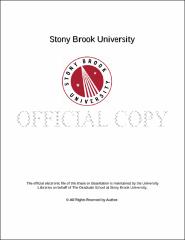| dc.identifier.uri | http://hdl.handle.net/11401/77265 | |
| dc.description.sponsorship | This work is sponsored by the Stony Brook University Graduate School in compliance with the requirements for completion of degree. | en_US |
| dc.format | Monograph | |
| dc.format.medium | Electronic Resource | en_US |
| dc.language.iso | en_US | |
| dc.publisher | The Graduate School, Stony Brook University: Stony Brook, NY. | |
| dc.type | Thesis | |
| dcterms.abstract | Containers or OS-based virtualization have seen a recent resurgence in deployment. Containers have low memory footprint and start-up time but provide weaker security isolation than Virtual Machines (VMs). Incapability to load kernel modules and support multiple OS, and platform-dependence limits the functionality of containers. On the other hand, VMs or hardware-based virtualization are platform-independent and are more secure, but have higher overheads. A data centre operator chooses among these two virtualization technologies —VMs and containers—when setting up guests on cloud infrastructure. Density and Latency are two critical factors for a data centre operator because they determine the efficiency of cloud computing. Therefore, this thesis contributes updated density and latency measurements of KVM VMs and Linux Containers with a recent kernel version and best practices. This work also studies the memory footprint of KVM VMs and Linux Containers. In addition, it identifies three ways to improve the density of KVM VMs by lowering the memory footprint: improving existing memory deduplication techniques, removing unused devices emulated by QEMU, and removing unused pages from the guest address space. | |
| dcterms.abstract | Containers or OS-based virtualization have seen a recent resurgence in deployment. Containers have low memory footprint and start-up time but provide weaker security isolation than Virtual Machines (VMs). Incapability to load kernel modules and support multiple OS, and platform-dependence limits the functionality of containers. On the other hand, VMs or hardware-based virtualization are platform-independent and are more secure, but have higher overheads. A data centre operator chooses among these two virtualization technologies —VMs and containers—when setting up guests on cloud infrastructure. Density and Latency are two critical factors for a data centre operator because they determine the efficiency of cloud computing. Therefore, this thesis contributes updated density and latency measurements of KVM VMs and Linux Containers with a recent kernel version and best practices. This work also studies the memory footprint of KVM VMs and Linux Containers. In addition, it identifies three ways to improve the density of KVM VMs by lowering the memory footprint: improving existing memory deduplication techniques, removing unused devices emulated by QEMU, and removing unused pages from the guest address space. | |
| dcterms.available | 2017-09-20T16:52:19Z | |
| dcterms.contributor | Porter, Donald E | en_US |
| dcterms.contributor | Stoller, Scott | en_US |
| dcterms.contributor | Ferdman, Mike. | en_US |
| dcterms.creator | Agarwal, Kavita | |
| dcterms.dateAccepted | 2017-09-20T16:52:19Z | |
| dcterms.dateSubmitted | 2017-09-20T16:52:19Z | |
| dcterms.description | Department of Computer Science. | en_US |
| dcterms.extent | 55 pg. | en_US |
| dcterms.format | Application/PDF | en_US |
| dcterms.format | Monograph | |
| dcterms.identifier | http://hdl.handle.net/11401/77265 | |
| dcterms.issued | 2015-12-01 | |
| dcterms.language | en_US | |
| dcterms.provenance | Made available in DSpace on 2017-09-20T16:52:19Z (GMT). No. of bitstreams: 1
Agarwal_grad.sunysb_0771M_12504.pdf: 1010080 bytes, checksum: 4feba47f8a43388bacf753e7362fbec7 (MD5)
Previous issue date: 1 | en |
| dcterms.publisher | The Graduate School, Stony Brook University: Stony Brook, NY. | |
| dcterms.subject | Engineering | |
| dcterms.subject | cloud computing, containers, deduplication, overheads, virtualization, VMs | |
| dcterms.title | A Study of Virtualization Overheads | |
| dcterms.type | Thesis | |

